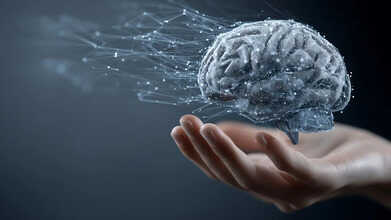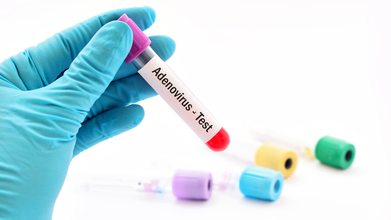- Health Conditions A-Z
- Health & Wellness
- Nutrition
- Fitness
- Health News
- Ayurveda
- Videos
- Medicine A-Z
- Parenting
Is The Viral 'Quad-demic' Still Swirling? Know The Good, Bad And Ugly

Image Credit: Health and me
There's been an alarming increase of respiratory and gastrointestinal viruses in the United States lately, causing anxiety about a so-called "quad-demic". According to surveillance reports, influenza, COVID-19, RSV and norovirus are at very high levels everywhere. While the surge aligns with patterns typical for this season, several epidemiologists view simultaneous infections of such proportions to pose risks not only to individual healthcare but public health.
The incidence of the quad-demic should vary with seasonal patterns, vaccination rates, and public health interventions. Each virus alone is relatively easy to manage; however, the effect of all together could lead to overburdening of health care facilities and increase risks for those at higher risk. Continuing surveillance, early testing, and proactive prevention measures will play an important role in the control of these infections going forward.
While the term "quad-demic" sounds daunting, it must be taken into perspective. For years, we have had all these viruses together, and we have the capabilities to mitigate some of the risk. Vaccination, proper hygiene and using common sense helps individuals get through the season unscathed. Is the quad-demic a permanent fixture or just another seasonal wave? Let's break this down.
What is the Quad-demic?
Typically, flu, COVID-19, and RSV have been the primary culprits behind seasonal respiratory infections. However, norovirus, a highly contagious stomach bug, has emerged as a fourth significant player, inducing fears of a more severe and widespread viral outbreak. According to the Centers for Disease Control and Prevention (CDC), the U.S. recorded nearly 500 norovirus outbreaks between August and December 2023, a substantial rise from the previous year’s numbers.
While the term "quad-demic" may sound ominous, the seriousness and consequences of such infections should be weighed in light of the U.S. healthcare system's experience with managing viral surges since the start of the COVID-19 pandemic.
1. Influenza (Flu)
Flu continues to be one of the most common and alarming seasonal illnesses. In the period spanning from 2023 to 2024, there were approximately 40 million cases of flu, and thousands of hospitalizations along with reported 47 deaths have been reported this season. Flu symptoms include fever, chills, cough, sore throat, muscle pain, and fatigue, with most recovering within a week or two but risky factors for severe illness effects occur in young children, elderly, and people with chronic conditions.
2. Covid-19
Despite its reduction from the first pandemic peak, COVID-19 is still rampant. The CDC estimates that alone between October and December 2023, there were between 2.7 and 5 million cases in the U.S. Hospitalization has increased by cities such as Los Angeles, Chicago, and New York. Symptoms are closely similar to the flu, fever, cough, and fatigue but uniquely presents in some cases as loss of taste and smell.
3. RSV
RSV is the most common cause of lower respiratory infections in infants, older adults, and immunocompromised individuals. While RSV peaked late in 2023 and early 2024, it continues to be a threat because it can lead to bronchiolitis and pneumonia. It is very similar to the common cold, presenting with symptoms such as congestion, runny nose, coughing, and fever, which can make it difficult to differentiate from flu or COVID-19 without testing.
4. Norovirus
Norovirus, also called the "stomach flu," is a highly contagious infection of the gastrointestinal tract, not a respiratory virus. It transmits quickly from contaminated food and water and contact with contaminated surfaces, causing such symptoms as diarrhea, vomiting, nausea, and stomach pain. Cases have shot up, the CDC said Monday, with reports of outbreaks surging compared with last year.
Is There a Challenge In Diagnosis Due to Overlapping Symptoms?
The greatest challenge during the quad-demic is how the four viruses are alike and thus make identification very hard with no testing applied. Most cases present symptoms common to all viruses: fever, tiredness, body pains, and respiratory, which includes coughing and congestions for influenza, COVID-19, and RSV; the other would be norovirus symptoms as nausea and vomiting can appear even in extreme influenza and COVID-19. This overlap increases the risk of misdiagnosis and delayed treatment, hence the need for early testing and proper medical guidance.
Also Read: Is US Preparing For A Quad- demic 2025?
Effective Prevention Strategies That Work
The best defense against these viruses is a combination of vaccines, hygiene, and lifestyle precautions. While lifestyle modifications are highlighted as part of the constant need to eat healthy, ensure daily movement and drinking adequate amount of fluids. There is a sure short two preventive strategies that are effective:
Vaccination
- Flu vaccine: Annual flu shots reduce the severity of infection, allergic flare ups and hospitalizations.
- COVID-19 vaccine: Though COVID-19 cases have declined, vaccination remains critical in preventing severe outcomes.
- RSV vaccine: Available for those aged 60 years and older, especially those with underlying conditions.
- Norovirus vaccine: No vaccine is yet available, but mRNA vaccine research is in progress.
Hygiene and Sanitation
- Washing hands frequently with soap and water for at least 20 seconds, especially after public exposure.
- Disinfect frequently touched surfaces regularly, use sanitiser when outside.
- Avoid close contact with infected people and wear masks.
Do You Need To Wear A Mask All The Time?
While debates on masked wear continue on, experts on mask-wear affirm that this does not only have a historical precedent but works towards reducing airborne viruses spreading within the environments. Hospitals, though, ensure masking in key sections of themselves. Publicized mask-wear remains a discretion, though massing indoors still goes a longer way in cases like peak flu seasons.
If you notice the symptoms of these viruses, then it's best to be confined at home and avoid having face-to-face interaction with others and seek immediate attention from your physician if your condition worsens. Quarantining for some days can decrease the spread of infection.
As we move into the first half of 2025 and beyond, staying informed and proactive is the best strategy for maintaining health and avoiding unnecessary panic. The key takeaway? Stay vigilant, but don’t be alarmed—these viruses are here, but so are the means to fight them.
Can Alzheimer’s Disease Be Reversed? Here’s What the New Research Shows

Credits: Canva
In what researchers are calling an important scientific advance, a team in the US has shown through animal experiments that Alzheimer’s disease may be reversible, overturning a belief that has shaped medical thinking for more than 100 years. For generations, the neurodegenerative condition was considered permanent and progressive. The findings, published in Cell Reports Medicine, are based on multiple preclinical mouse models as well as examinations of human Alzheimer’s brain tissue.
The study found that preserving a healthy balance of NAD, a molecule central to cellular energy production, could both prevent and reverse Alzheimer’s-related damage. NAD plays a key role in brain function and is now seen as a major contributor to the disease process. Researchers also observed that NAD levels drop much more sharply in the brains of people with Alzheimer’s, a pattern that was mirrored in mouse models of the condition.
Don't Miss: Taking Tramadol? Scientists Warn It May Cause More Harm Than Relief
Alzheimer’s Disease Can Be Reversed, New Study Shows
“We were extremely encouraged by what we observed,” said Andrew A. Pieper, the study’s senior author and Director of the Brain Health Medicines Center at the Harrington Discovery Institute, University Hospitals, as per Sciencedirect. “By restoring the brain’s energy balance, we saw both structural and functional recovery in mice with advanced Alzheimer’s.”
Pieper noted that the effect appeared consistently across two very different mouse models, each driven by separate genetic mechanisms linked to Alzheimer’s in humans. “Seeing recovery in models caused by distinct genetic pathways strengthens the case that restoring NAD balance in the brain could have real therapeutic potential for patients,” he said.
For the study, researchers examined mice engineered to carry genetic mutations known to cause Alzheimer’s disease in people. One group of mice carried multiple human mutations affecting amyloid processing, while the second group carried a human mutation in the tau protein.
After confirming that brain NAD levels dropped sharply in both human Alzheimer’s tissue and mouse models, the team tested whether stopping this decline before symptoms appeared could prevent disease, and whether restoring NAD levels after the disease had progressed could reverse it. To do this, they used a well-studied drug called P7C3-A20 to restore NAD balance in the brain.
The results were striking. Not only did maintaining NAD levels prevent Alzheimer’s from developing in mice, but starting treatment later, after the disease was already advanced, allowed the brain to repair the main pathological damage caused by the genetic mutations. In both mouse models, cognitive abilities were fully restored.
What Is NAD In Alzheimer’s?
In Alzheimer’s disease, NAD, short for nicotinamide adenine dinucleotide, is an essential coenzyme whose levels naturally decline with age. This decline disrupts energy production, mitochondrial health, DNA repair, and the ability of neurons to withstand stress. Research suggests that increasing NAD levels, often through precursors such as nicotinamide riboside, may reverse Alzheimer’s-related damage, improve memory, and correct abnormal RNA processing in animal models. Because of this, NAD has become a major area of focus for developing new Alzheimer’s therapies, according to the National Institutes of Health.
Why NAD Is Important In Alzheimer’s
- Energy and Mitochondria: NAD is necessary for producing ATP, the cell’s main energy source, and for keeping mitochondria functioning properly, both of which are critical for healthy brain cells.
- Cellular Stress: NAD supports neurons in responding to and surviving stress. When NAD levels fall in Alzheimer’s, these protective mechanisms weaken.
- DNA Repair: NAD is involved in repairing DNA damage, which increases as amyloid-beta accumulates in the brain. Low NAD levels interfere with this repair process.
- RNA Splicing: Emerging research shows that NAD may help correct faulty RNA splicing events linked to Alzheimer’s. This process may involve a protein called EVA1C and could contribute to improved memory and better clearance of harmful proteins.
Next Steps Toward Human Trials
The findings also pave the way for further research and eventual testing in people. The technology behind the treatment is currently being developed for commercial use by Glengary Brain Health, a Cleveland-based company co-founded by Dr. Pieper.
“This recovery-based treatment approach now needs to be tested in carefully designed clinical trials to see if the benefits seen in animals can be replicated in humans,” Pieper said.
He added that future laboratory work will focus on identifying which components of brain energy balance matter most for recovery, exploring additional strategies that could complement this approach, and determining whether similar methods could work for other long-term, age-related neurodegenerative diseases as well.
Adenovirus Cases Rise In UK, Health Authorities On Alert

Credits: Canva
Adenovirus, or what some people are calling the mystery disease is going to be the next worry in the UK, after superflu had already grappled the healthcare system. Along with H3N2 and its variant superclade K, people are now worrying about this mystery disease.
Adenovirus is highly contagious and causes mild cold or flu-like symptoms, though severe cases could lead to stomach flu and vomiting. Many describe this virus as 'heartier' than others. The reason is that the virus can survive longer on surfaces and even resist the common disinfectants used. This is what makes it highly transmissible.
Is There Any Treatment For Adenovirus?
As of now, there is no treatment for adenovirus, it could however be managed and monitored. What helps is regular handwashing and thorough cleaning of surfaces.
The good news is that cases of adenovirus are actually dropping in the UK, as confirmed lab reports. The cases last week were 1.2 per cent, whereas the week prior, it was at 1.7 per cent, as also reported by the Independent.
What Are The Symptoms Of Adenovirus?
While a lot of the symptoms mimics of those in flu or COVID, including shortness of breath, a sore throat and or a runny nose. However, there are certain unique symptoms of adenovirus that include:
- Diarrhea
- Pink Eye or conjunctivitis
- Ear infection or otitis media
- Swollen lymph nodes
- Pneumonia
- Stomach pain
- Nausea
- Vomiting
Other rare symptoms could also include impact on your bladder or nervous system. As viruses in your bladder can also cause urinary tract infections, and the same virus in your nervous system can cause condition that can affect your brain. These conditions also include encephalitis and meningitis.
The symptoms usually start to subside within two days, however, if the symptoms stay even after three days without any relief, it might be a red flag. The best thing to do during such a situation is to go consult your GP.
Also Read: Unique Symptoms Of Mysterious Adenovirus And How Long Infection Now Last
Is Adenovirus Spreading Faster Than Flu and Covid?
Experts have noted that due to its ability to stay longer in the environment and being highly transmissible, it is in fact, spreading faster than flu and COVID. Eric Sachinwalla, Jefferson Health's medical director said that this virus is still unfamiliar and thus not much can actually be done to treat adenovirus. Speaking to PhillyMad, he said, "It is pretty contagious because it is heartier than other viruses - soap and water, or everyday disinfectant, won't kill it, so it tends to live in the environment longer."
What Are The Ways To Stay Safe From Adenovirus?
Since adenovirus spreads through close contact and is resistant to many everyday disinfectants, hygiene remains the key. The best way to stay safe is by avoiding close contact, especially with those who are unwell. You may also keep an eye on your symptoms, including your body temperature and take steps to prevent the virus from spreading by taking precautions, as well as getting the flu jab.
WHO Approves Two COVID-19 Rapid Antigen Tests, Check The Details Here

Credits: iStock
The World Health Organization (WHO) on December 24 prequalified two rapid antigen diagnostic tests (Ag-RDTs) for SARS-CoV-2. This virus is known to have caused COVID-19. As per the WHO, these two tests are called SD Biosensor STANDARD Q COVID-19 Ag Test and the ACON Biotech Flowflex SARS-CoV-2 Antigen Rapid Test (Self-Testing).
At first these tests got temporary emergency approval from the WHO during the pandemic. This was done so the countries could start using them quickly even though long-term data was limited. This emergency approval helped the tests reach over 100 countries when they were urgently needed.
What Has Changed Now?
The WHO has now given these tests full prequalification, which means it has a stronger and long-term approval. This means that the WHO has thoroughly checked and confirmed that the tests consistently meet global standards for quality, safety, and accuracy.
Why Does This Matter?
- The tests can now be officially bought and used by global organizations and governments
- They can be included in bulk purchasing to lower prices and increase supply
- This makes reliable COVID-19 testing more affordable and accessible, especially in low-and middle-income countries
COVID-19 Is Far From Being Over
Even though WHO officially ended COVID-19 emergency phase over two years ago, the virus is still circulating globally. In fact, this year, we have seen variants of COVID-19 circulating around, causing the most unique symptoms, including razor-blade like throat. Variants like JN.1, Stratus, Nimbus, LP8.1, and BA.3.2 were all that we saw in 2025.
While the good news is that infection levels are relatively stable, but the virus has not completely disappeared and testing is still necessary, especially in poorer countries.
Many low-income countries do not have easy access to labs or expensive PCR testing. So there is still a need for a strong, but cheaper and reliable way to detect COVID-19, and these tests may as well do that.
Why Rapid Antigen Test Matters
- Give results in 15–30 minutes
- Cost less than PCR tests
- Don’t require labs or specialized equipment
- This means they can be used in small clinics, community centers, mobile vans, or remote areas, where lab testing isn’t practical.
However, it is important to note that rapid antigen tests are not replacement for PCR tests. They simply complement the PCR tests by allowing faster, on-the-spot decisions, especially when the lab capacity is limited.
What Makes It Essential Today?
Rapid antigen tests could help with spotting and stopping local outbreaks quickly, protecting high-risk people and healthcare workers, and staying prepared for future respiratory pandemics.
The WHO is also pushing for decentralized, quality-checked testing as part of universal healthcare and global health security, so countries aren’t caught unprepared when the next outbreak happens.
When Is It A Right Time To Get Yourself Checked For COVID-19?
If you notice these following symptoms as noted by the Centers for Disease Control and Prevention (CDC), it is best that you get yourself a COVID-19 test:
- Fever or chills
- Cough
- Shortness of breath or difficulty breathing
- Sore throat
- Congestion or runny nose
- New loss of taste or smell
- Fatigue
- Muscle or body aches
© 2024 Bennett, Coleman & Company Limited

